As an amateur scholar and die-hard enthusiast of everything to do with Alice in Wonderland, I have launched a Podcast that takes on Alice’s everlasting influence on pop culture. As an author that draws on Lewis Carroll’s iconic masterpiece for my Looking Glass Wars universe, I’m well acquainted with the process of dipping into Wonderland for inspiration. The journey has brought me into contact with a fantastic community of artists and creators from all walks of life—and this podcast will be the platform where we come together to answer the fascinating question: “What is it about Alice?”
It is my great pleasure to have David Rutsala join me as my guest. Read on to explore a sampling of our conversation, and check out the series on your favorite podcasting platform to listen to the full interview.
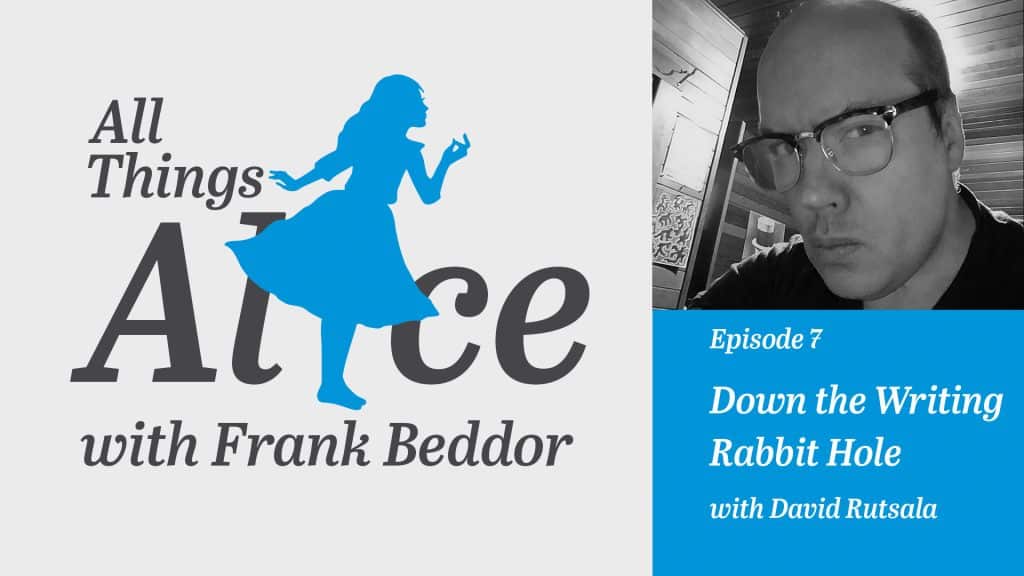
Frank Beddor
I’m excited to chat with David today because we have been collaborating for many, many years, on all sorts of different aspects of The Looking Glass Wars and other projects. But one of the more rewarding parts of our collaboration has been the novel of the Hatter M graphic novels.
How did you come to Alice in Wonderland?
David Rutsala
I was thinking about that. It’s so hard for me to pinpoint because my mother was always quoting stuff. She was always quoting Alice in Wonderland and other Lewis Carroll writings, so it was always around. I do have a memory of the first time it was just read to me rather than being read to, my siblings and me, but just being read to me. That opening section is so powerful with her falling down the hole and drinking the potion and I just remember being blown away by that.
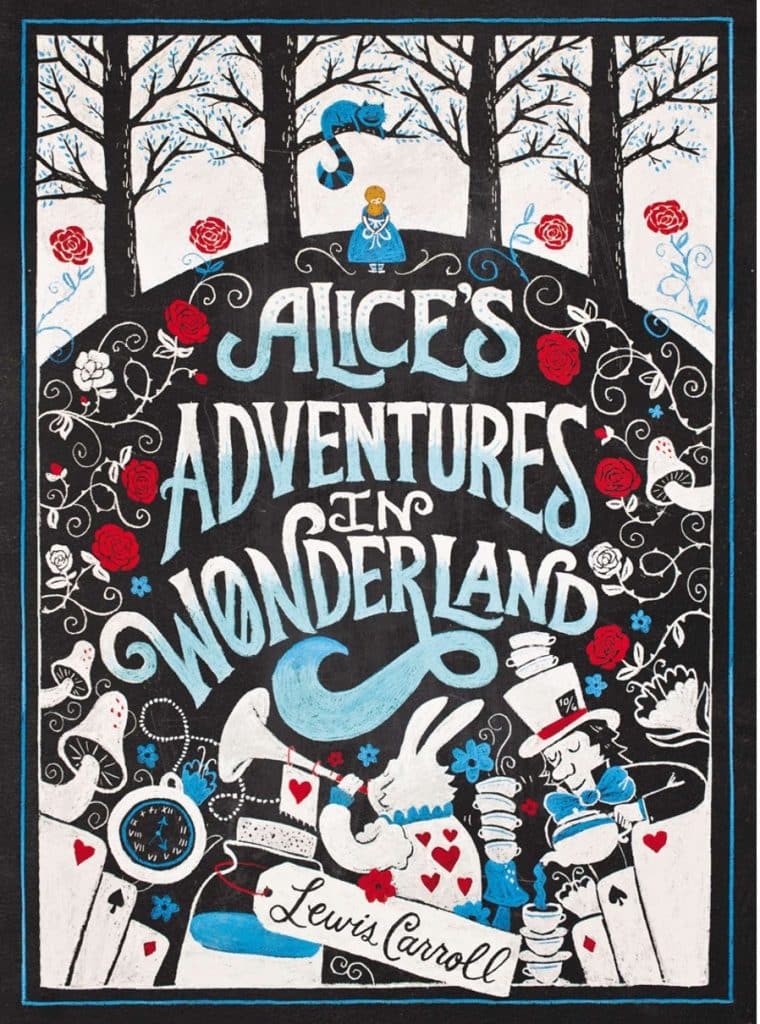
FB
Was that something that your parents did on a regular basis? Reading stories to you as a family or individually.
DR
That was something my mother really did. Occasionally my father would, but my mother was very theatrical so that was something she really liked to do. She would even read to my father, in the evening, from the newspaper and he liked that.
FB
What was her favorite? Did she have a favorite to act out and be theatrical? Or do you recall a childhood favorite?
DR
One of my strong memories is of her reading Treasure Island to me. I could tell it was a special thing. There used to be a thing of, “When is the kid ready for Treasure Island?” Especially young boys because it’s such a classic boy’s adventure story. It’s just so magical, the way it opens and it’s scary. It feels like you’re being given a new experience because it’s kind of an adult thing, with the black spot and there’s other scary stuff in there.
FB
It’s like Grimms’ Fairy Tales and so many other books that were written back then. I was a big fan of Treasure Island because it was scary, but also because of the adventure aspects. I remember I was doing an interview with Michael Morpurgo, the British Children’s Laureate and he was giving me a hard time about reimagining Alice in Wonderland, but he finally came around. But he gave me a word of warning: Don’t touch Treasure Island. I said, “I’m putting it in space.”
DR
They did do that. Treasure Planet.
FB
Luckily, I didn’t work on it. But do you have one, a classic that you ever thought about reimagining?
DR
I do, but one of them is something I’m working on so we can’t talk about it. It’s something, one of the many things, I worked on during the pandemic because it was one of the things that when that started, I was like, “I am not coming out of this with nothing accomplished.” And as I wrote a massive book for you.
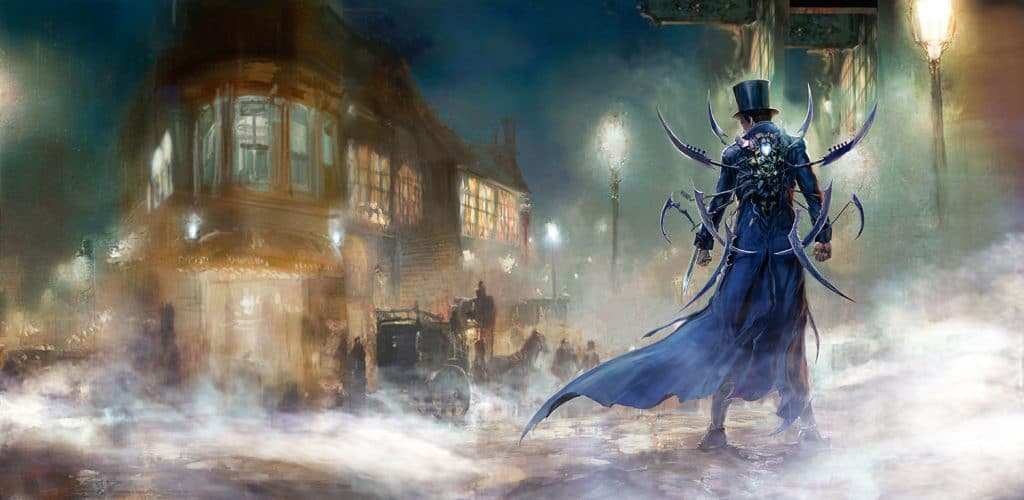
FB
Let’s set it up and tell the listeners what exactly this book is and how it came about.
DR
Originally, Frank came to me, and he wanted to do something about the Hatter M graphic novels because he’d noticed that there were some people who just didn’t want to read graphic novels, and they loved his novels. He thought we could do novelizations of graphic novels. I think you were thinking about other people, and I lobbied for myself really hard. You were not totally convinced but I put together an outline. At that stage, I think I had it as three books and I felt like the Alyss energy needed to be in there in some respect. So, I created a new character, a teenage Victorian journalist with her own backstory, who was hunting Hatter. That was basically my addition to the structure. Then I found a way to tell all the stories within the graphic novels and add new ones. I recall, you read that, and you really liked it. But your big note, you had many notes, but your big note was it needs Alyss. It wasn’t something we’d ever thought about because it wasn’t right, the initial conception. I remember when I first talked to you about the Penelope character, the reporter, I was saying, “There’s gonna be a lot of Alyss energy here and there and she’ll be sort of an echo over the whole piece.”
But still, you felt like it needed Alyss and the minute you said it, I knew you were right. One of the really exciting things for me was that meant we could expand one of the chapters in your first book about Alyss on the streets of London. Because that was my favorite chapter was many people’s favorite chapters.
FB
Also, I skipped over a number of her teenage years, so I thought, “Oh, it’d be really interesting to explore what was going on with her.” But structurally, the idea that these two people are separated on planet Earth, and they’re slowly inching their way together, just made sense.
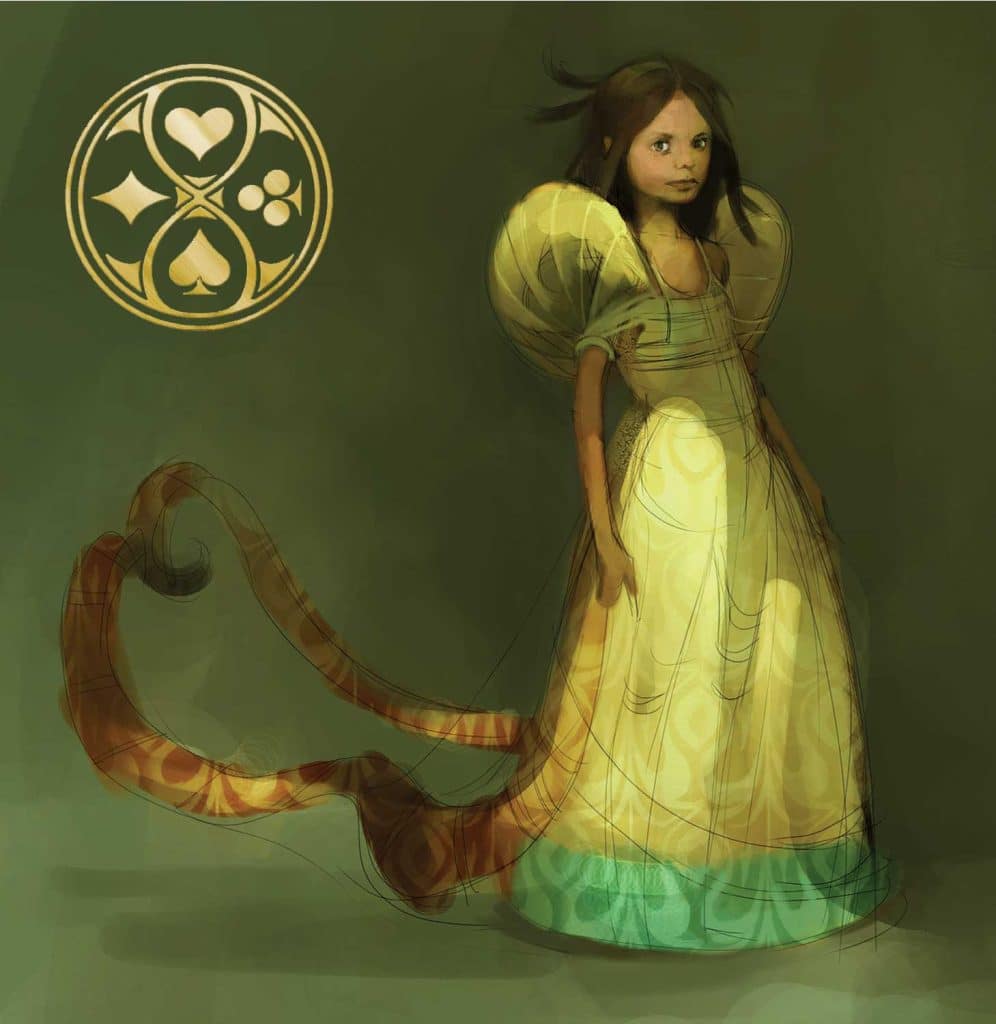
DR
My simple one liner on it always was, Hatter’s searching for Alyss, Penelope is searching for Hatter, and Alyss is searching for herself. That was always the guiding thing that I think is one of the reasons I could write such a long piece because I always knew what it was about. I always knew the motivation of the characters because when you go into one of these like picaresque-style stories, one of the problems is often you lose the thread. But the strength of this material that you’d set up was that the thread was so strong that you would never lose it. Hatter’s looking for Alyss. Penelope is a journalist and she’s looking for Hatter. She doesn’t even know he’s Hatter originally, he’s just this mysterious monster character that she hears of and reads of in European papers.
FB
Because you have the background of pitching and selling and creating TV and film properties, you have a really strong sense of how to position something and how to sell something. I remember we were talking about a pitch I was going to do for The Looking Glass Wars. You were helping simplify it and one of the things you came up with was what people are looking for today, in terms of creating a new myth, but not a myth that has to do with good and evil, but a myth about truth versus fiction. You’re also able to crystallize thematically what these ideas are about, and how they’re going to find their way into pop culture.
Since working on The Looking Glass Wars, and taking this deep dive into Alice in Wonderland, have you noticed how much Alice in pop culture there is to draw upon? Or how often it’s referenced?
DR
That was rather stunning to me. I would have probably imagined it was strong and present, but it just was just everywhere, literally. I encounter a reference to it pretty much every day. There’s so many. “Down the rabbit hole,” you hear that almost every day nowadays because it’s become, people go down a YouTube “rabbit hole”. That’s one that’s so ingrained in us, I don’t think people are even thinking, Alice in Wonderland.
FB
It often morphs. In The Matrix, they turned the liquid into pills. Then I read an article about taking the red pill, which was a whole article about the internet, and about how deep that rabbit hole goes. But they were using a Matrix invention to talk about Alice in Wonderland. It keeps feeding on itself. It’s quite remarkable.

DR
“Through the looking glass,” right? That’s another one of those expressions that you hear a lot, but actual direct quotes and references are just as prevalent. An article I’m putting together for your site is the Star Trek connection. As I did a little research on that, I discovered that Alice in Wonderland, its use in the original series, and in Star Trek Discovery actually makes the Star Trek animated series canon. That’s an amazing thing. I was going through one of my early old Star Trek reference books from right around the time the animated series came out and it even has an entry for Lewis Carroll.
FB
Would you say that because you’re a fan of Star Trek that Star Trek using Alice in Wonderland is one of your favorite connections?
DR
It’s one of my favorites. Of course, it’s used in such specifically different ways that evoke different things. That’s the thing about Alice in Wonderland. It can be so many different things. It’s an example of a fantasy world. But then you can look at Alice in Wonderland as the opposite thing, which is, it’s us looking at our world. It’s a tool to examine our world. I always love in Oliver Stone’s JFK, when Costner as Jim Garrison says, “We’re through the looking glass people. Black is white and white is black.” The great thing about that is everybody understands. Even if they’re not going, “Looking Glass, Alice in Wonderland,” in their brain.
FB
They know that it’s a shorthand. It’s a vocabulary that we’ve developed around it, and that’s why you don’t really recognize and or you can recognize it so quickly.
DR
I honestly feel like, after going through this process of working on this material with you, that I think Alice in Wonderland is right up there with Shakespeare and the Bible as the most influential works of literature that have been wedded so deeply into our culture, that we don’t even notice it.
FB
What do you think it is about Alice in Wonderland, that has endured in culture, but not quite endured in film and television in the same way as, for example Sherlock Holmes and even The Wizard of Oz? Alice, until the Tim Burton movie came out, I would say that 90% of the people would recognize the Disney animated movie, but that was from 1951.
DR
You’re absolutely right. I think some of it is just the daunting nature of going up against Disney. The Jungle Book had adaptations before, other than the Disney film. Largely the material Disney has done is in the public domain, Snow White, Sleeping Beauty, not a lot of other people have taken it on. Recently you had Guillermo del Toro taking on Pinocchio, but only a couple of people have tried that. I think the Disney effect is part of it. The other thing is, with Sherlock Holmes and Tarzan and similar properties, people saw as more natural story generators and they saw Alice more as one story.
FB
That’s a good point. Story generators versus, Alice’s story being episodic and having a definitive end.
DR
Wizard of Oz is there’s another one. There are 13 books. I read them all as a kid and we only really have a couple of adaptations. The Judy Garland movie. The Return to Oz movie from the 80s. I think there’s an animated patchwork girl. But there’s very little for the amount of material there. I think sometimes it’s the daunting nature of going up against an iconic cinematic version. Some of it is the inherent nature of that story. To some degree, Alice in Wonderland is a daunting, dense story. It’s a story where if you actually take the book itself, and go, there’s a lot in there that you can stage. The sequence where she grows, you’re getting all this stuff about drugs, all this stuff we have in our heads because it’s such a powerful thing over the years. Then you’re going well, how can we get some of that into this adaptation? Tim Burton tried to do that to some degree.
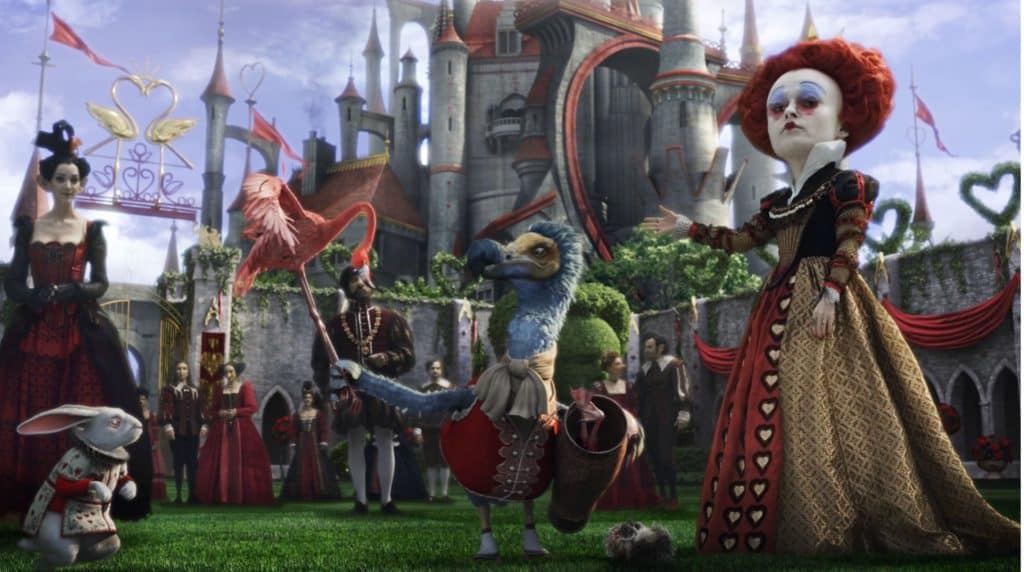
FB
The success of Tim Burton’s movie pushed a lot of people away from trying a new version of Alice or The Looking Glass Wars, especially with directors. Tim Burton’s movie made a billion dollars and having done the sequel and now it’s many, many years later, and seeing other reinventions come out. There’s the opinion that there’s nowhere to go. As you said, there’s no story engine to keep driving the Wonderland mythos.
DR
That was the most powerful thing, almost instantly, with your material that I felt. The first thing I felt was, “Why didn’t I come up with this?” That was one of the first things I said to you.
FB
I remember that.
DR
It seems so obvious. You can even present it with that cheesy title – Alice in Wonderland: The True Story.
FB
Except to suspend disbelief in that storytelling, you really have to work with the reality of Lewis Carroll and the books and the real Alice Liddell, and then play with the fiction of it.
DR
That was an exciting thing that you did. That’s something that’s part of the Alice in Wonderland myth in and of itself. If you go a little deeper, you encounter that. That’s why I was jealous, because you were taking on two levels of the myth at once, and then finding a way to tell that story. But then when I looked at it more deeply, I realized you’ve created this story engine that you can keep going back to and that, to me, was the most impressive thing. I think I demonstrated in the book we’re doing that it really has a massive story engine. It can just keep going and going.
FB
I don’t think I realized until my first book. The first book was published in the UK, and I went to a school event. There was a very eager boy raising his hand, who asked, “How come you didn’t finish the book?” And I said, “What do you mean?” He said, “Well, you just did a recap of Hatter’s 13 years. He’s my favorite character. You should go home and finish those 13 years and include them in the book.” I’m like, “How old are you, kid?” Then I realized on the plane ride home, that was a really strong story engine, because it’s such a long period of time that they’re separated. I just started to imagine all the people he would have met in our world at the time. The friendships he would’ve made, the influence he would’ve had, and how he would have left awake of mythology behind him. That’s when I realized that this story could be infinite. When he met President Lincoln or Jules Verne and Jules Verne was inspired to write one of his books because of Hatter. You can do this endlessly.

DR
Those 13 years on Earth are one of the most important periods because so much changes. You have the Industrial Revolution taking over the world and then you have astronomy taking off. There’s just so much stuff that didn’t exist at the beginning. Revolver pistols didn’t exist. Just on and on. One of the things was when I was doing research, I would always have to double check, “Does this exist at this time?” I was always trying to make sure that everything in the book fit all the other material that’s already out there. So, I was always doing little things to make that work. For example, I discovered that Budapest did not exist at the time. It was Buda and Pest.
FB
It was my mistake. I did not do as much research as you did.
DR
But I covered your ass. I put in a line about how, like, people are already starting to call it Budapest.
FB
You called me and you busted my ass so bad. You’re like, “Oh, do you want to know one of the many mistakes you’ve made? I’m gonna fix it for you.”
DR
But it’s indicative of that period that a lot of stuff is changing. That’s another thing that makes the Hatter story so exciting because he’s a catalyst living in a time of catalysts. A time of imagination. One of my feelings always about your story is it’s about recapturing the imagination for our culture. The 20th century was the century of imagination and the 21st century really hasn’t been, in fact it’s been a century, so far, of reversion.
FB
Of killing imagination. You really feel it in culture and the need break out of this. I had this quote from the novels, “Fantasy just declared war on reality.” I really never thought it would apply to day-to-day life.
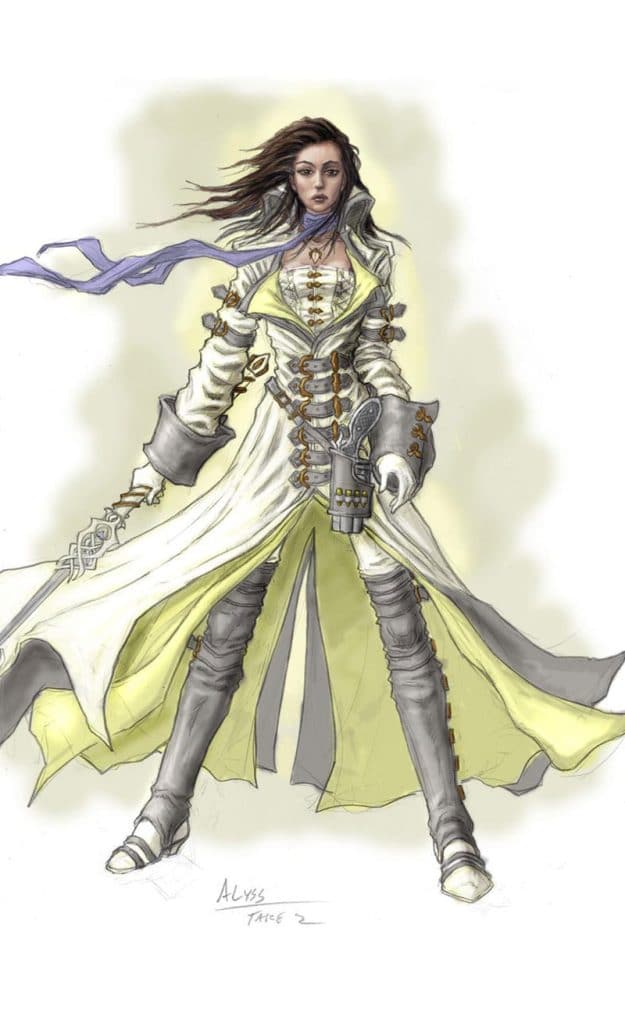
DR
One of the exciting things about the story is seeing what the destruction of imagination can do to a world. What just one girl, who has this great power of the White Imagination, what she can do on a positive side, for the world, and for the people that surround her. One of the great things in the Hatter stories is this thing you invented, “follow the glow”. The glow is something that Hatter can see that indicates some kind of special imagination is going on. That idea to me was very exciting and that’s another little thing that I’ve always wanted to return to or even have a point where Hatter wants to return to that.
FB
What do you think Lewis Carroll would say? If he was here, given everything we’ve been doing with his story.
DR
I think he’d probably be more interested in where mathematics has gone. I think he would be like, “But quantum quant…Wait, wait, wait. The laws? Imaginary?” He’d be interested in some of this amazing stuff that’s happened in mathematics because he was a mathematician.
FB
I think you’re right. I think he would say that his Wonderland survived for 157 years. Let me go off and do something more interesting in mathematics. That’s a great answer.
DR
He was a person who was very amused by the world that he lived in. I think that if he saw what we were doing, he would get a kick out of it. He wouldn’t necessarily say that’s what he would do but he would say, “Well, it’s for your world not mine.” We have to remember that he made massive changes between Alice Underground and Alice in Wonderland. He was not averse to rethinking. The Tea Party doesn’t exist in that original manuscript. That’s an amazing leap of imagination. I know that part of it was just, there’s mundane levels where children’s stories usually have like dinner scenes, some kind of food scene. It didn’t have one of those so he put it in but it’s become one of the most iconic elements of the story so you would think would have been there on the first pass.
FB
David, this has really been a joy to talk about your work and our collaboration and Alice in pop culture.
DR
I think that listeners can see how we’ve collaborated for so long. Because we just got through an hour and a few minutes without stopping. No issue and we probably didn’t even cover half the things.
FB
We absolutely haven’t. But hopefully they’re interesting to the listeners and because of what you were saying about your imagination, your childhood love of writing and continuing that into adult life, I’ll end with something that that Harry Miller said, “Imagination is the voice of daring.” I think that’s been very true in your work. It’s been a pleasure to collaborate with you and to chat with you today. Thanks so much, my friend.
If you liked my interview with David and All Things Alice, please consider donating to this GoFundMe campaign to finish There’s Something About Alice, the documentary featured last episode, so it can be shared with the world.
Should you decide to support the documentary on GoFundMe, please send your receipt as proof of donation to automaticstudio@gmail.com to claim one of the following rewards:
For more information on Looking Glass Wars & Alice in Wonderland, check out the All Things Alice Blogs From Frank Beddor